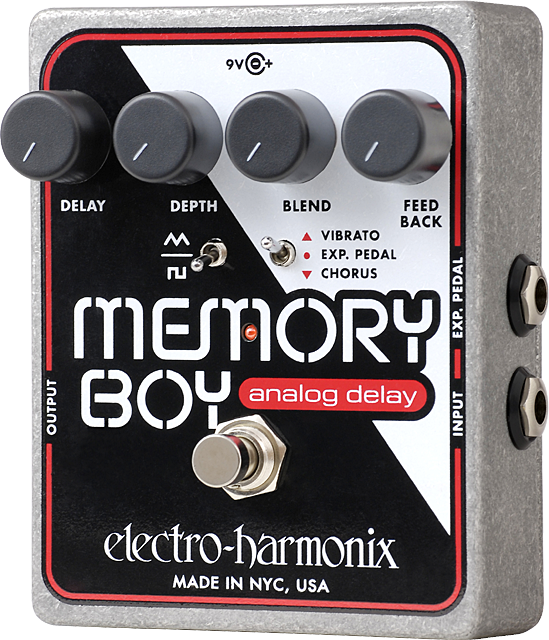Today I’m sharing something I’ve been doing a lot lately and can make mixing a lot of fun.

Use guitar pedals for mixing
Plugins are great but its just not the same as running sounds through real analog circuits. You can send sounds out of your audio interface, tweak the pedal settings and even ‘play’ the pedal to do realtime automation. It can be a lot of fun to work this way.
For the demonstration I’ve recorded an electric guitar directly into my DAW with Amplitube for amp and cabinet simulation. I’m going to then run the signal through an Electro-Harmonix Memory Boy analog delay pedal.
Here is the sound of the direct guitar.
Direct Guitar
[audio:http://audiogeekzine.com/wp-content/uploads/GTR_DI.mp3|titles=Direct Guitar]
Here is the guitar with the Amplitube 3 plugin added (stereo, amp+speaker+mic)
Guitar + Amplitube
[audio:http://audiogeekzine.com/wp-content/uploads/GTR_AmpSim.mp3|titles=Guitar + Amplitube]
Now I’m going to run the sound through the pedal. To do this in your home studio you need an audio interface
with a couple spare analog outputs, if your interface has 4 analog
outputs, that’s perfect.
Connect a guitar cable from output 3 of
the interface to the input of the pedal. Connect the ouput of the pedal
to one of the instrument inputs of your interface (usually in 1 or 2). In this case, I’m going from output 5 through the Memory Boy and into input 1 of my Profire 2626.
In the DAW you need to tell the signal where to go. Most DAWs will have a plugin for hardware inserts. In this next example I have the hardware insert before the amp, just like if I had the pedal before the amp. When you do this remember to keep the mix control of the pedal to about 50% or less, you still want to have the clean guitar get through.
Hear how it sounds with the delay before the amp
Guitar + analog delay insert
[audio:http://audiogeekzine.com/wp-content/uploads/GTR_delay_insert.mp3|titles=Guitar + Analog Delay Insert]
There’s another way to use pedals and that’s as a separate FX track. Add a new mono track to your project. You can either use the the hardware insert plugin again and have the other tracks send to this track, or set the track to monitor the analog input and have the other tracks send to the analog output.
Here I have the guitar track sending to my delay track, which has the hardware insert plugin set the same as before. The direct guitar signal goes into amp plugin, then to the master output. The signal from this track is also going to the delay track. It then goes into the insert plugin, out the interface, into the delay, (set to 100% wet, no clean sound) and then into the interface and to the same track. I hope this makes sense. The benefit of doing it this way is you can blend in as much of this signal as you want. You can also use plugins before and after to shape the sound independently of the original tracks. Also, you can send multiple tracks in at the same time.
Here is the guitar through the delay as a send. (delay after the amp in the chain)
Guitar + Delay Send
[audio:http://audiogeekzine.com/wp-content/uploads/GTR_delay_send.mp3|titles=Guitar + Delay Send]
And finally, here is what the delay track sounds like soloed.
Delay Return Soloed
[audio:http://audiogeekzine.com/wp-content/uploads/GTR_delay_return_solo.mp3|titles=Delay Return Soloed]
Pedal are inexpensive, easy to use and a lot of them really sound great on more than just guitars. Have fun!

RT @theaudiogeek: New on AGZ: Using Guitar Pedals For Mixing http://t.co/IDZHaw29
@theaudiogeek Nice. Check my blog tomorrow for a link to it.
Using Guitar Pedals For Mixing http://t.co/dIwwqNhj via @zite
Definitely worth exploring what you can use guitar pedals on other than guitars…it’s amazing what they can make a guitar sound like so how about…a voice?
Using Guitar Pedals For Mixing http://t.co/olsgi59n
Using Guitar Pedals For Mixing http://t.co/zriTDUgL
Audio Geek Zine: Using Guitar Pedals For Mixing – http://t.co/TMmaWAIY – #recordingideas
RT @RobSommerfeldt: Audio Geek Zine: Using Guitar Pedals For Mixing – http://t.co/TMmaWAIY – #recordingideas
Using guitar pedals for mixing (#music) http://t.co/v8okYSJ4
When you get the guitar and your amp, for sure your want to get the sound your have in your head. That is why it is important to have the right effects pedals. I started with a Wah pedal long time ago and I remember the feeling I got when I first tried it.
Also, a multi effects pedal can be a good choice for a beginner.
Love the fact that you put sound to show the sound
Useful information
http://www.bestguitareffectspedals.org
If your mixer send/return is unbalanced, it’s probably hi-z too. Try and see if you like the results.
Many people have successfully used guitar effects at line level with no extra stuff (read about Tchad Blake’s use of a Classic Sansamp). Often the signal to noise is much improved this way – although the saturation characteristics are completely different – you will need much lower settings, which also helps reduce the noise.
A Reamp box is excellent for reducing a hot balanced output down to a cooler unbalanced guitar level. A DI box used in reverse goes the wrong way – it boosts the signal, which is exactly what you don’t want. It unbalances the signal, but doesn’t attenuate. That’s why a Reamp box is very different from a DI box, and ideally uses a different transformer.
The overhead of using a Reamp and then a DI is probably worse than just using the pedal direct – if possible. Things like impedance matching are fairly fickle – you just have to use whatever works best.
http://musicalstudy.com/